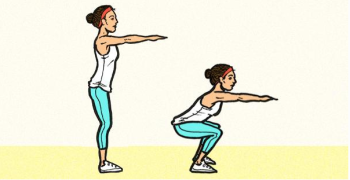Did you know the biggest (and strongest) muscle in your body is the gluteus maximus? Followed by your leg muscles (quads and hamstrings)?
Squats are a full body fitness staple that work the hips, glutes, quads, and hamstrings, and sneakily strengthen the core. And they can help improve balance and coordination, as well as bone density, too. That’s why it’s one of my “go to” exercises.
If you haven’t added squats into your regular exercise routine, now’s the time. Check out these tips on how to do the perfect squat and how to avoid some of the most common mistakes people make when performing this move.
How to do the perfect squat
- Place your feet a little wider than shoulder-width apart, hips stacked over knees, knees over ankles.
- Roll your shoulders back and down away from the ears. If you allow your back to round (like a turtle’s shell, it will cause unnecessary stress on your lower back.
- Extend your arms out straight so they are parallel with the ground, palms facing down (like your hands are on someone’s shoulders at a 7th grade dance). Or, if it’s more comfortable, pull your elbows close to the body, palms facing each other and thumbs pointing up.
- Start the squat by inhaling into your belly, and unlocking your hips, slightly bringing them back. Keep sending hips backward as your knees begin to bend.
- While your butt starts to stick out, make sure the chest and shoulders stay upright, and your back stays straight. Keep your head facing forward with eyes straight ahead for a neutral spine.
- Let your hip joint squat lower to the ground than the knees, if comfortable. Pro tip: Try squatting onto a box or chair. Gently tapping it with your butt at the bottom of the squat will be a physical reminder of how low you should go.
- Engage your core, and exhale while driving through the heels to return to standing. Imagine the feet are spreading the floor (the left foot to the left, right foot to the right) without actually moving the feet.
- Squeeze your glutes together at the top of the movement for a little more work.
As you perfect your form, you can start challenging your body by:
- Adding repetitions
- Adding weight (Note: when using more weight, it’s more difficult to squat deeper. But deep squats with less weight trump shallow ones with heavy weight when it comes to making us stronger
- Adding intensity (by doing jump squats)
How to avoid common squat mistakes
The Mistake: Not dropping down low enough.
The Fix: Take a slightly wider stance, which allows your body to stay steady while it squats deeper, and engages more muscle groups. It’s easy to want to squat just low enough so the thighs are parallel with the ground, but squats can be much more effective when we drop as low as possible (the hip joint lower than the knee joint) while still maintaining good form
The Mistake: Your knees drift inward.
The Fix: Turn the toes out (between 5 and 20 degrees to get technical) to keep knees from caving inward. Your knees should track in line with both the ankles and the hips, to help avoid injury and get deep in the squat. Floor bridges and lying clams will help knees from caving.
The Mistake: Your body leans too far forward.
The Fix: Put most of your weight in your heels when lowering into a squat. The weight distribution will help keep your torso upright through the squat rather than teetering forward, and help keep your hips back and down, outside of the heels. Try to spread the floor apart by driving outwards through the back/outer portion of the heel.
The Mistake: Descending too quickly.
The Fix: When you add weight to a squat, moving too quickly could increase your chances of getting hurt. It’s okay to return to standing position with some power—as long as your body remains controlled—but sitting into the squat should be done a little slower to maintain proper form.
The Mistake: Not warming up.
The Fix: Before squatting up a storm, try floor bridges to open up your hips (which will allow the body to get lower in a squat). Warming up is important before taking on such a complex move. It’ll help prepare the body’s joints and muscles for movement, and might even help prevent injury once heavy lifting get underway.
Try it now
Try one of these workout routines that includes squats:
You'll also receive my Eating for Fat Loss tip sheet with six simple strategies you
can put to use right now.




